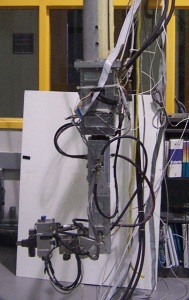

 I
work on a robot known as SAMII
which stands for Small Articulated Manipulator II. SAMII is
mounted on the end of a flexible base (a cantilevered beam).
SAMII is short and rigid compared to the base. The flexible base
represents a long arm that would be used to move SAMII into position
where SAMII would then be used for finer motions. I
work on a robot known as SAMII
which stands for Small Articulated Manipulator II. SAMII is
mounted on the end of a flexible base (a cantilevered beam).
SAMII is short and rigid compared to the base. The flexible base
represents a long arm that would be used to move SAMII into position
where SAMII would then be used for finer motions. This configuration of a small robot mounted on the end of a larger robot is called a macro-micromanipulator. SAMII is the micromanipulator and the flexible base (a cantilevered beam) represents the macromanipulator with its joints locked. (An example of this configuration would be a long arm on a space vehicle with some type of hand on the end of it). The macromanipulator needs to be long to provide a large workspace and perform the functions it is designed for, but the length of the arm makes it flexible. As a consequence of the flexibility of the base, moving SAMII can result in substantial vibrations, as can be seen in this video clip (note that this is a 2mb Quicktime .mov file - use right click and Save Target As if you have problems viewing this clip in your web browser). A fairly simple motion can lead to base vibration that lasts over 20 seconds. Building on the work of Lynnane George and others, I am seeking ways to control SAMII so that the interaction forces between SAMII and the flexible base damp base vibrations. This method of vibration reduction is called active mass damping (or inertial damping). SAMII is a mass that is actively controlled to damp base vibrations. Here is another video clip (1.4mb .mov file) that compares base vibrations resulting from moving SAMII with and without mass damping.  |
|